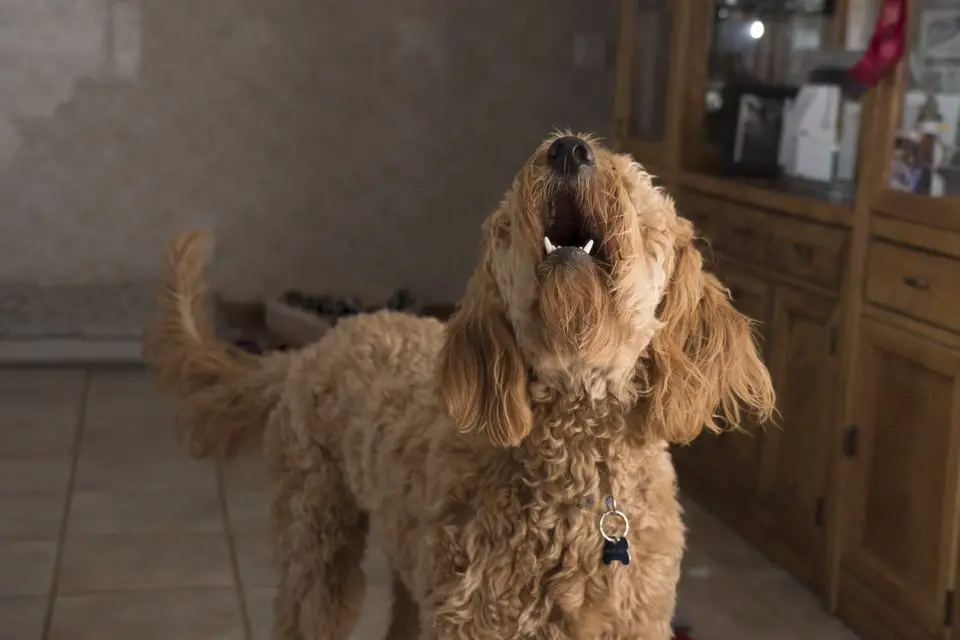You know how you say the word walk in front of your dog and it’s like a fire cracker went off in your living room, or is that just me?
Dogs pick up on certain words that they associate with actions, so when you ask your dog “Do you want to go on a walk?” (don’t deny it, we all do it), they start to recognize that that means they get to go sniffing around outside!
Teaching dogs how to speak on command sounds like a real challenge, but it can actually be easier than you think.
Even if you have an older dog like me, dogs are incredibly smart animals and can learn things no matter what age they are.
All it takes is a little patience, a lot of praise and treats never hurt! If you are willing to dedicate some time to your dog, they are sure to learn all sorts of new tricks.
Hello dog moms and dads! My name is Bri, and when I adopted my American Bulldog/Pitbull mix, Bruce, I wanted to see what kind of tricks he could do.
Bruce was 9 years old when I adopted him, so many people told me the old saying “you can’t teach an old dog new tricks!”
Well Bruce says that’s bully! We soon found out that he had never been taught to do any tricks on command, so we figured there’s no time like the present. It took a little time, but Bruce was able to speak on command in no time!
How We Taught Bruce to Speak on Command
Starting off, Bruce was not a very vocal dog.
He was able to sit and shake on command with no problem, but speaking was a new concept for him.
We had to try a few methods to find the perfect one.
Teaching a Dog to Speak on Command: The Treat Method
 We decided that any time he would bark, we would grab a treat, say “speak” and if he barked again, we would give him a treat and praise.
We decided that any time he would bark, we would grab a treat, say “speak” and if he barked again, we would give him a treat and praise.
This seemed to work pretty well, but he still wasn’t sure what we wanted him to do when we just said “speak” at random.
This sounds silly, but we started barking at Bruce and I swear it worked. By making a barking noise and saying “speak” to him, he was able to mimic the noise.
As we kept doing this method, he picked it up very quickly! Can I put “fluent in dog” on my resume?
Teaching a Dog to Speak on Command: The Toy Method
Another method that worked for us was to pick up his favorite toy or bone.
He would get excited to play, so we would say “speak” and only give him the toy once he barked.
He picked up on this method much faster than the treat trick.
Within just a few weeks, Bruce was barking on command with no hesitation.
The Quiet Bark? SShhhh!
We ended up trying some new tricks with Bruce, including my favorite one, his quiet bark. For whatever reason, Bruce started doing a very quiet bark that was absolutely adorable.
I had the thought that if he could pick up a normal on-command bark, why couldn’t he pick up a hushed one? So, I literally started shushing my dog.
I probably looked like a crazy person, but I would stand in front of him, treat in hand and finger in front of my mouth just like my fourth-grade science teacher.
When Bruce would bark, I would repeat “sshhhhh” until he’d let out the sweetest little hushed bark.
As you probably could guess, I went crazy with affection once he mastered this. Now, Bruce is able to differentiate between “speak” and “ssshhhh.” SUCH A GOOD BOY!
It did take a few weeks for us to get this down and he still gets them mixed up sometimes when he is super excited. However, for an old man, he picked up these tricks pretty quickly!
How to Teach a Dog to Bark on Command Prerequisites
 We all know that it’s best to teach our dogs things at a young age. This helps the pup develop their skills over time and learn them as part of their daily routine.
We all know that it’s best to teach our dogs things at a young age. This helps the pup develop their skills over time and learn them as part of their daily routine.
However, if you’ve ever had a puppy, I’m sure you know how easily distracted they can be. This is where the toys and treats can really come in handy.
There are definitely some things you want to do before teaching your dog to speak that will make it much easier. Let’s take a look at those first!
Eliminate Distractions
Puppies can become distracted by anything from a bug on the wall to a car horn in the distance. To help keep your pup focused, try teaching them commands in the emptiest space you can find.
This should be a quiet room without other people in it, without any toys laying around, and ideally without any open windows.
Closing your blinds can also help keep your puppy from daydreaming about catching the squirrel on the tree outside.
Use toys and treats to hold their attention.
Keep your dog focused with toys and treats.
If they start to become distracted, start over!
It takes a ton of patience so take deep breaths and try again.
Start with the basics.
In my opinion, it’s easier to teach a puppy to sit and lay down before you teach them to speak.
Learning these basic commands can help your dog focus on what you’re saying and understand that there are rewards associated with listening to what you are saying.
Dogs are smart and will pick up these skills rather easily. However, it does take patience! By pushing your pup’s bottom to the floor when you tell them to sit, they will quickly associate the command with the action and reward.
 Same goes for laying down. Gently help them to the floor in a laying position while giving the command. Treat and repeat!
Same goes for laying down. Gently help them to the floor in a laying position while giving the command. Treat and repeat!
If you need extra help teaching your dogs to sit, lay down or other basic commands, Brain Training for Dogs has simple steps and videos to help you take your dog’s discipline to the next level!
This training tool dives deep into detail on the best ways to train your dogs to do basic commands, as well as more advanced training. It breaks it all down into modules that give you everything you need for doggy school 101.
From sitting to dropping toys, to fetch and more, they have multiple courses you can take to educate yourself and your dog. I’ll be trying some of these methods with Bruce, but that’s a story for another day!
Step by Step: Teaching a Dog to Speak on Command
Once you are able to get them to sit and pay attention, start teaching them to speak.
Step 1: Tell your dog to sit and hold his attention with a toy or treat.
Step 2: Say the command in a clear, loud voice while showing your dog the treat or toy.
Step 3: Wait for your dog to bark and only after they bark, give them the treat or toy.
Step 4: Repeat! Continue to say the command and reward them when they follow it. They will catch on in no time.
Don’t forget to reward your puppy and give them plenty of praise when they speak on command.
This will help them associate the positive reaction from you and the tasty treat with the noise they make and the command you give.
Other Tips to Teach a Dog to Bark on Command
Like I said about when I was training Bruce, don’t be a softy! Those puppy dog eyes can break anyone, but only give treats and praise when they follow your commands.
Otherwise, they could become even more confused when you don’t reward them just for looking at you!
While I taught Bruce using English words, many people will use other languages to train their dogs. I’ve been told that this helps the dog know when their human is directing the command at them.
But honestly, you could teach your dog to speak when you use the word “zebra” and they wouldn’t know the difference, as long as you’re consistent! For Bruce, we’ll stick to English.
 Patience is key when working with your dog! The worst thing you can do is get frustrated and scold them when they don’t get it.
Patience is key when working with your dog! The worst thing you can do is get frustrated and scold them when they don’t get it.
Your dog is learning something new which can be confusing for them, so by making it as familiar as possible, they will be able to pick it up faster. This is why we used things like toys that we knew already made Bruce bark.
Once he started associating the command with his actions, he understood right away what we wanted from him.
Also, be consistent! When we were trying to teach Bruce the hushed bark, we had to avoid giving him treats when he let out a powerful bark.
Final Thoughts
So, give it a try with your dog. Whether it’s a brand-new puppy or an old angel you just gave a new home to, patience is the key.
Hopefully this helps you learn some new ways to teach your dog how to speak!
Happy Pet Parenting!

